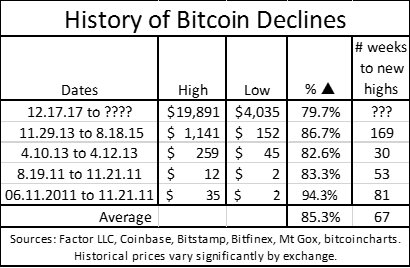Bitcoin (BTC) has experienced five major corrections to date, and the recent bear market of 2018 is the smallest major correction to date.
As seen in a table shared by a renowned trader and technical analyst Peter Brandt, BTC experienced a drop of 79.7 percent in the past eleven months as its price declined from $19,500 to $4,035.
On November 21, Bitcoin experienced a steep decline from $4,500 to $4,050 on fiat-to-cryptocurrency exchanges like Kraken and Coinbase. The dominant cryptocurrency swiftly recovered back to $4,500, but the sudden flash crash to the $4,000 support level placed BTC close to reaching an 80 percent drop from its all-time high.
Still Hope
Throughout the past nine years, BTC went through four large corrections excluding the 2018 bear market. In 2011, 2013, and 2015, Bitcoin recorded drops in the range of 82.6 percent to 94.3 percent, declining by 85.3 percent on average.
For BTC to record an 85 percent loss from its all-time high, it would have to drop to $2,950. But, there still is strong support at the $4,000 support level.
Even if BTC drops to $2,950, an 85 percent drop from its all-time high is only the average loss BTC recorded in the past four major corrections.
Previous corrections can be considered as references and could provide clues for when the current bear market may end. However, market conditions, infrastructure, and mainstream awareness are vastly different from 2011, 2013, and 2015.
The 79 percent decline in the price of BTC from $19,500 is said to be mainly caused by a lack of liquidity in Bitcoin markets. Trading giant Susquehanna executive Bart Smith noted that there are no viable investment vehicles for a regular retail trader. It is still difficult, without specific know-how, to invest in the cryptocurrency market.
In 2015, apart from some announcements of merchant adoptions, there were no signs of a major financial institution, bank, or asset manager of integrating major cryptocurrencies to improve the usability and accessibility of the asset class.
This year, Fidelity, the world’s fourth-largest asset manager, and ICE, the parent company of the New York Stock Exchange, introduced Fidelity Digital Assets and Bakkt to assist both retail investors and institutional investors in the traditional finance sector in investing in crypto.
The short-term price trend of cryptocurrencies does not accurately portray the last eleven months of positive developments in the cryptocurrency sector, and for that reason, high profile investors like billionaire Tim Draper, Mike Novogratz, and Susquehanna executive Bart Smith remain optimistic in the long-term trend of Bitcoin.
Smith explained:
“That has led to the second problem which is without the new capital on-ramp, liquidity has been very low. And so we’ve kind of seen a stable price all through summer, it was at $6,000 give or take. Volatility got really light at the end of July. So what happens is in that environment, if you have a contentious fork, it does not necessarily create a tremendous amount of confidence and when those sellers come in, there’s just no liquidity to absorb it. Hopefully, with Bakkt, Fidelity, and further regulations, there are going to be enough capital to soak it up.”
$4,000 is the Bottom?
It is too early to confirm that the cryptocurrency market has achieved a bottom and that BTC has stabilized in the low price range of $4,000 to $4,500.
Depending on the short-term price trend of BTC throughout November, several potential catalysts like Bakkt and a Bitcoin exchange-traded fund (ETF) decision in February could trigger an accumulation period throughout the first quarter of 2019.
Featured image from Shutterstock.









